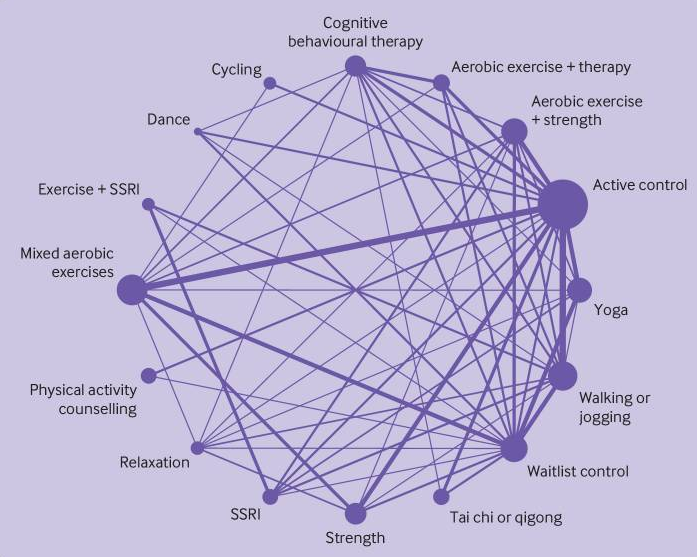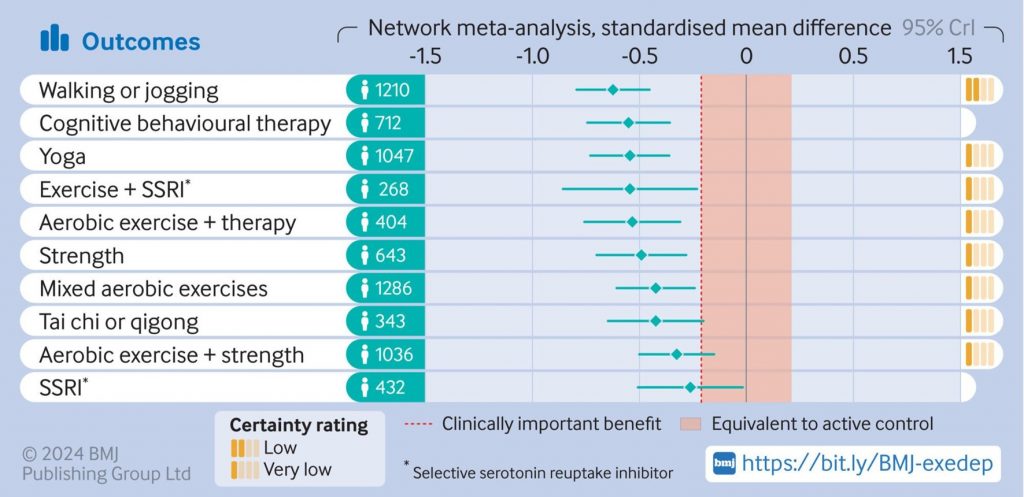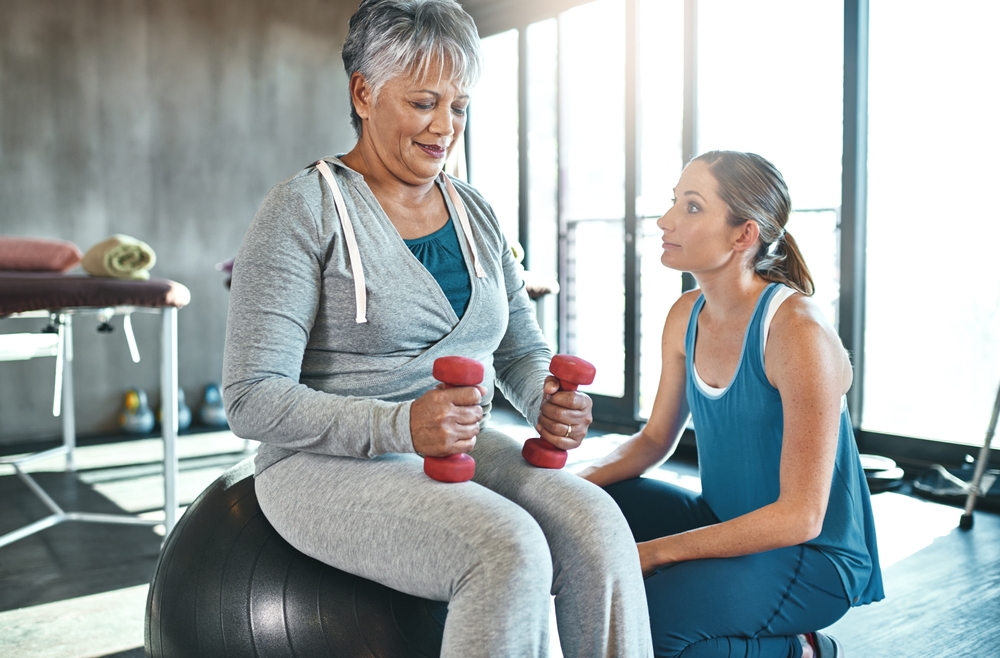
Train-based interventions, doubtlessly serving as both various remedies for melancholy or alongside treatment and/or remedy, are really helpful by the UK Nationwide Institute for Well being and Care Excellence (NICE). Train is a broad time period, and may vary from gradual guided motion resembling yoga, to high-intensity energy or cardio coaching, and quite a few scientific trials for melancholy have been performed over the previous a number of a long time. Understanding the effectiveness of various kinds of train in treating melancholy, and whether or not particular actions is perhaps higher suited to completely different people, is essential for the event of each interventions and remedy tips.
Earlier Psychological Elf blogs have coated analysis establishing the effectiveness of train as a remedy for melancholy (Nedoma, 2023), together with a meta-analysis discovering train interventions to be “non-inferior to present first line remedies” (Heisel et al., 2023). As famous by Francesca Bentivega in her 2022 weblog, though reductions in melancholy from train interventions are noticed reliably, the mechanisms behind these adjustments are poorly understood, and will properly differ between people and varieties of train (Bentivegna, 2022).
Of their 2024 overview, Noetel and colleagues aimed to determine the handiest sorts and quantities of train (referring to each the size of intervention and frequency of classes) for treating melancholy, and potential elements that affect who is probably going to answer remedy (often known as moderators).
Strategies
5 databases have been searched over a two-year interval, figuring out 18,658 papers, with 54 further research recognized from earlier evaluations. After preliminary screening, 1,738 research have been assessed for eligibility, with 218 assembly the inclusion standards and included within the evaluation. These inclusion standards have been:
- Randomised managed trials
- Longer than one week in size
- At the very least one train group
- Contributors met scientific cut-offs for main melancholy
- Melancholy reported as an end result
- Satisfactory knowledge to calculate an impact dimension for every research arm.
The first evaluation comprised a multilevel community meta-analysis, which in precept permits for a comparability between various kinds of train throughout research, with impact sizes offered as advantages past ‘lively management’ circumstances. Management circumstances diversified considerably between research, for instance: regular care, placebo pill, stretching, instructional management, or social assist; for the aim of study, the authors mixed these circumstances right into a single ‘lively management’ group.
Outcomes
The ‘community geometry’ determine from the paper (reproduced beneath) illustrates the variety of members in every intervention arm (indicated by the scale of the circles) and the variety of direct comparisons between arms (indicated by the thickness of the strains). It reveals notable variations within the frequency with which completely different interventions have been investigated, and that completely different train sorts have principally been in contrast with ‘lively management’; there are only a few direct comparisons between various kinds of train, or with first-line remedies for melancholy (i.e. selective serotonin reuptake inhibitors (SSRIs) or cognitive behavioural remedy (CBT)).

The intervention teams included within the meta-analysis, with the scale of the dots indicating the variety of members, and the thickness of the strains indicating the variety of direct comparisons between research arms. [View full size graphic]
Hedges g scores (within-subject standardised imply variations, often known as impact sizes) have been calculated for every research arm individually (i.e., post- versus pre-intervention, the place a extra destructive quantity signifies a higher discount in melancholy), and aggregated throughout research inside every intervention class. Every intervention was then in contrast with ‘lively management’ (summarised beneath).

Impact sizes from every intervention in contrast with ‘lively management’. The yellow bars on the suitable point out credibility scores, based mostly on each pattern dimension and the authors’ judgment of research high quality. [View full size graphic]
Conclusions
The principle conclusions of the research are as follows:
- A number of varieties of train proved efficient as remedies for melancholy, for instance strolling or jogging, yoga, and energy coaching, with dancing exhibiting notably robust results (albeit with decrease certainty owing to the small pattern dimension);
- Extra intense train was related to a higher antidepressant impact;
- Advantages gave the impression to be comparable for various baseline melancholy scores, and comorbidities;
- Age and gender would possibly affect which train kind is prone to be efficient, though this must be confirmed in research particularly designed to analyze particular person variations.
The authors conclude that remedy tips round train for melancholy could at present be too conservative, and that tailoring train to particular person affected person traits would possibly improve the possibilities of success.

Present train tips for melancholy could also be too cautious. Personalising train plans to suit every particular person may increase their possibilities of feeling higher.
Strengths and limitations
The rigorous inclusion standards and large breadth of research screened are essential strengths of the overview. Solely randomised managed trials together with members who reached scientific cut-offs of melancholy have been analysed, that means we will be assured that the outcomes reported replicate the consequences of interventions on members with scientific melancholy.
The appliance of community meta-analysis can be a energy, because it doubtlessly permits for the comparability of various kinds of intervention, regardless of the dearth of many direct comparisons inside research. Nonetheless, the kind of “arm-based” community meta-analysis utilized on this research can be a weak point, as in contrast to “contrast-based” evaluation, it doesn’t protect the randomised side of comparisons inside trials; due to this fact, warning have to be utilized when weighing up the effectiveness of various interventions on this method, owing to the oblique nature of the comparisons. This limitation is especially related to the comparisons between various kinds of intervention (e.g., train vs SSRIs), particularly because the authors didn’t really evaluate any of the completely different interventions statistically. Nonetheless, the outcomes present a helpful illustration of which varieties of train are mostly investigated, what they’ve been in comparison with, and preliminary indications of which of them work finest. This lays the groundwork for future analysis to handle understudied areas. Equally, the rigour with which the authors assessed the danger of bias and research high quality permits the identification of weak factors throughout the present literature.
One complication in deciphering the outcomes is using a mixed ‘lively management’ situation, comprising regular care, placebo pill, stretching, instructional management, or social assist. For instance, presumably ‘stretching’ has a number of comparable options to ‘yoga’ or ‘tai chi/qigong’, whereas ‘instructional management’ may doubtlessly be fairly much like ‘bodily exercise counselling’. These gray areas between the ‘lively management’ and intervention teams, with the mixed ‘lively management’ group together with interventions much like these with each clinically essential advantages (e.g., stretching and leisure), and people beneath that threshold (e.g., bodily exercise counselling), may muddy the waters, doubtlessly leading to both under- or over-estimation of impact sizes.
Moreover, as any comparability between interventions throughout the evaluation is essentially oblique (as few research included a couple of kind of train), a excessive stage of warning is critical when drawing conclusions. That is notably related for interventions with decrease pattern sizes and few direct comparisons, resembling dance, as estimates of the distinction between interventions might be imprecise. Equally, the potential intercourse and age variations recognized via exploratory moderation analyses are very preliminary and require additional investigation, particularly as analyses have been based mostly on the typical gender combine or age in every research arm, fairly than investigated on the particular person participant stage.
An extra and substantial limitation is the small pattern dimension of many of the research included within the meta-analysis (on common <30 members per arm, and fewer than ten research included >100 members), in addition to clear proof for publication bias (this refers to the truth that research reporting vital outcomes usually tend to be printed). This raises the prospect that the outcomes of the meta-analysis might not be correct, as impact sizes for train interventions vs ‘lively management’ might be over-estimated. Nonetheless, it’s price noting that even when analysing solely research that reported a non-significant outcome, the authors nonetheless noticed a big impact when evaluating train (throughout every kind) with ‘lively management’, albeit unsurprisingly with a a lot smaller impact dimension. To handle this problem, we’d like massive trials that consider the effectiveness of train interventions, ideally incorporating a number of intervention arms (which might permit for direct comparisons between various kinds of train).
A remaining limitation is much like the purpose raised within the aforementioned weblog “Cardio train improves signs in college students with main melancholy”, which emphasised our lack of knowledge relating to the mechanisms via which train improves melancholy. While this research lays out the proof base supporting the implementation of train as a remedy for melancholy, the mechanisms behind its effectiveness stay unclear – particularly given the wide selection actions studied, which presumably may function via completely different mechanisms. Moreover, the varieties of train exhibiting promise diversified significantly by way of group/solo format, depth, motion kind, muscle teams used, and cardio/anaerobic calls for, elevating essential questions as to which of those elements are most essential for treating melancholy, and underscoring the significance of mechanistic analysis. Though preliminary proof of mediating elements, resembling shallowness, self-efficacy, and social connection exists (White et al., 2024), these elements have primarily been assessed utilizing self-report questionnaires, and the cognitive, neural and physiological mechanisms driving these adjustments are far much less properly understood. To handle this query, mechanistic randomised managed trials are required, which might contain taking cognitive, neural and physiological measures earlier than, throughout and after train and management interventions, within the context of a randomised design.

All kinds of actions may help deal with melancholy, starting from yoga and tai chi to high-intensity energy and cardio coaching.
Implications for apply
Though bodily exercise is really helpful by the World Well being Organisation (WHO) and included within the UK NICE tips for melancholy, arguably it isn’t ‘prescribed’ at a frequency commensurate with its supporting proof base. Along with summarising the prevailing literature supporting using train interventions for melancholy, this paper gives preliminary proof for the potential utility of tailor-made train suggestions based mostly on particular person traits, in addition to suggesting that extra intense train is prone to be simpler.
Retaining train in thoughts as a viable remedy possibility for melancholy is advisable, and emphasising its potential not simply as a substitute, but additionally doubtlessly as an addition to first-line remedies, could also be essential to encourage extra uptake. Neighborhood-based exercise courses particularly designed for individuals with melancholy are extraordinarily unusual within the UK, due to this fact growing funding for exercise-based interventions inside psychological well being or major care providers may result in higher consciousness and cut back present obstacles to each prescription and attendance.
Importantly, few research within the meta-analysis obtained follow-up knowledge for greater than three months, and due to this fact the longer-term affect of train on melancholy stays unsure – even when train is efficient, it’s doubtless that if people cease exercising then the danger of relapse might be excessive. Due to this fact, a key purpose by way of implementation in providers needs to be to encourage individuals to keep up an train routine in the long term, after the top of a programme of courses. For instance, this is perhaps achieved by designing interventions that may be carried out extra virtually into individuals’s lives, and routines such because the idea of train ‘snacks’ (Thøgersen-Ntoumani et al 2024).
One other method of facilitating a cultural shift in the direction of higher use of train in psychological well being settings is thru understanding the mechanisms driving constructive change. For instance, the LIFE Trial at present going down at College School London (UCL), is investigating the organic, neural, and psychological processes modified by train in melancholy. If such analysis does yield improved mechanistic understanding, it couldn’t solely improve affected person and healthcare professionals’ willingness to think about it, but additionally present additional indications as to how train interventions will be tailor-made to people.

Regardless of being included in NICE and WHO tips, train shouldn’t be ‘prescribed’ sufficient for individuals with melancholy.
Assertion of pursuits
The authors are a part of the research workforce of the LIFE Trial talked about within the ‘Implications for Observe’ part, however in any other case declare no conflicts of curiosity.
Acknowledgements
Honest due to the remainder of the UCL LIFE research workforce (Prof Glyn Lewis, Prof Mark Hamer, Dr. Emily Hird, Dr. Elle Newton, Ashley Slanina-Davies, Jehanita Jesuthasan) for his or her feedback and suggestions that helped form this weblog, to Prof Deborah Caldwell for kindly answering a number of statistical queries, and to Dr Michael Noetel, the primary creator of the mentioned paper, for his well timed and detailed responses to our enquiries throughout the writing course of.
Hyperlinks
Major paper
Noetel M, Sanders T, Gallardo-Gómez D, Taylor P, Del Pozo Cruz B, van den Hoek D, Smith JJ, Mahoney J, Spathis J, Moresi M, Pagano R, Pagano L, Vasconcellos R, Arnott H, Varley B, Parker P, Biddle S, Lonsdale C. (2024) Impact of train for melancholy: systematic overview and community meta-analysis of randomised managed trials – PubMed. British Medical Journal 2024, 384 q1024.
Different references
Francesca Bentivegna (2022) Cardio train for main melancholy: the position of reward processing and cognitive management. https://www.nationalelfservice.web/remedy/train/aerobic-exercise-major-depression/
Ross Nedoma (2023) Train for melancholy: an evidence-based remedy possibility. https://www.nationalelfservice.web/remedy/train/exercise-for-depression-an-evidence-based-treatment-option/
Heissel, A., Heinen, D., Brokmeier, L. L., Skarabis, N., Kangas, M., Vancampfort, D., Stubbs, B., Firth, J., Ward, P. B., Rosenbaum, S., Hallgren, M., Schuch, F. (2023). Train as drugs for depressive signs? A scientific overview and meta-analysis with meta-regression. British Journal of Sports activities Drugs 2023 57 1049-1057.
Thøgersen-Ntoumani, C., Grunseit, A., Holtermann, A., Steiner, S., Tudor-Locke, C., Koster, A., Johnson, N., Maher, C., Ahmadi, M., Chau, J. Y., & Stamatakis, E. (2024). Selling vigorous intermittent way of life bodily exercise (vilpa) in middle-aged adults: an analysis of the movsnax cell app. BMC public well being, 2024 24(1) 2182.
White, R. L., Vella, S., Biddle, S., Sutcliffe, J., Guagliano, J. M., Uddin, R., Burgin, A., Apostolopoulos, M., Nguyen, T., Younger, C., Taylor, N., Lilley, S., Teychenne, M. (2024). Bodily exercise and psychological well being: a scientific overview and finest proof synthesis of mediation and moderation research. Worldwide Journal of Behavioural Diet and Bodily Exercise, 2024 21(134)
Picture credit

Train-based interventions, doubtlessly serving as both various remedies for melancholy or alongside treatment and/or remedy, are really helpful by the UK Nationwide Institute for Well being and Care Excellence (NICE). Train is a broad time period, and may vary from gradual guided motion resembling yoga, to high-intensity energy or cardio coaching, and quite a few scientific trials for melancholy have been performed over the previous a number of a long time. Understanding the effectiveness of various kinds of train in treating melancholy, and whether or not particular actions is perhaps higher suited to completely different people, is essential for the event of each interventions and remedy tips.
Earlier Psychological Elf blogs have coated analysis establishing the effectiveness of train as a remedy for melancholy (Nedoma, 2023), together with a meta-analysis discovering train interventions to be “non-inferior to present first line remedies” (Heisel et al., 2023). As famous by Francesca Bentivega in her 2022 weblog, though reductions in melancholy from train interventions are noticed reliably, the mechanisms behind these adjustments are poorly understood, and will properly differ between people and varieties of train (Bentivegna, 2022).
Of their 2024 overview, Noetel and colleagues aimed to determine the handiest sorts and quantities of train (referring to each the size of intervention and frequency of classes) for treating melancholy, and potential elements that affect who is probably going to answer remedy (often known as moderators).
Strategies
5 databases have been searched over a two-year interval, figuring out 18,658 papers, with 54 further research recognized from earlier evaluations. After preliminary screening, 1,738 research have been assessed for eligibility, with 218 assembly the inclusion standards and included within the evaluation. These inclusion standards have been:
- Randomised managed trials
- Longer than one week in size
- At the very least one train group
- Contributors met scientific cut-offs for main melancholy
- Melancholy reported as an end result
- Satisfactory knowledge to calculate an impact dimension for every research arm.
The first evaluation comprised a multilevel community meta-analysis, which in precept permits for a comparability between various kinds of train throughout research, with impact sizes offered as advantages past ‘lively management’ circumstances. Management circumstances diversified considerably between research, for instance: regular care, placebo pill, stretching, instructional management, or social assist; for the aim of study, the authors mixed these circumstances right into a single ‘lively management’ group.
Outcomes
The ‘community geometry’ determine from the paper (reproduced beneath) illustrates the variety of members in every intervention arm (indicated by the scale of the circles) and the variety of direct comparisons between arms (indicated by the thickness of the strains). It reveals notable variations within the frequency with which completely different interventions have been investigated, and that completely different train sorts have principally been in contrast with ‘lively management’; there are only a few direct comparisons between various kinds of train, or with first-line remedies for melancholy (i.e. selective serotonin reuptake inhibitors (SSRIs) or cognitive behavioural remedy (CBT)).

The intervention teams included within the meta-analysis, with the scale of the dots indicating the variety of members, and the thickness of the strains indicating the variety of direct comparisons between research arms. [View full size graphic]
Hedges g scores (within-subject standardised imply variations, often known as impact sizes) have been calculated for every research arm individually (i.e., post- versus pre-intervention, the place a extra destructive quantity signifies a higher discount in melancholy), and aggregated throughout research inside every intervention class. Every intervention was then in contrast with ‘lively management’ (summarised beneath).

Impact sizes from every intervention in contrast with ‘lively management’. The yellow bars on the suitable point out credibility scores, based mostly on each pattern dimension and the authors’ judgment of research high quality. [View full size graphic]
Conclusions
The principle conclusions of the research are as follows:
- A number of varieties of train proved efficient as remedies for melancholy, for instance strolling or jogging, yoga, and energy coaching, with dancing exhibiting notably robust results (albeit with decrease certainty owing to the small pattern dimension);
- Extra intense train was related to a higher antidepressant impact;
- Advantages gave the impression to be comparable for various baseline melancholy scores, and comorbidities;
- Age and gender would possibly affect which train kind is prone to be efficient, though this must be confirmed in research particularly designed to analyze particular person variations.
The authors conclude that remedy tips round train for melancholy could at present be too conservative, and that tailoring train to particular person affected person traits would possibly improve the possibilities of success.

Present train tips for melancholy could also be too cautious. Personalising train plans to suit every particular person may increase their possibilities of feeling higher.
Strengths and limitations
The rigorous inclusion standards and large breadth of research screened are essential strengths of the overview. Solely randomised managed trials together with members who reached scientific cut-offs of melancholy have been analysed, that means we will be assured that the outcomes reported replicate the consequences of interventions on members with scientific melancholy.
The appliance of community meta-analysis can be a energy, because it doubtlessly permits for the comparability of various kinds of intervention, regardless of the dearth of many direct comparisons inside research. Nonetheless, the kind of “arm-based” community meta-analysis utilized on this research can be a weak point, as in contrast to “contrast-based” evaluation, it doesn’t protect the randomised side of comparisons inside trials; due to this fact, warning have to be utilized when weighing up the effectiveness of various interventions on this method, owing to the oblique nature of the comparisons. This limitation is especially related to the comparisons between various kinds of intervention (e.g., train vs SSRIs), particularly because the authors didn’t really evaluate any of the completely different interventions statistically. Nonetheless, the outcomes present a helpful illustration of which varieties of train are mostly investigated, what they’ve been in comparison with, and preliminary indications of which of them work finest. This lays the groundwork for future analysis to handle understudied areas. Equally, the rigour with which the authors assessed the danger of bias and research high quality permits the identification of weak factors throughout the present literature.
One complication in deciphering the outcomes is using a mixed ‘lively management’ situation, comprising regular care, placebo pill, stretching, instructional management, or social assist. For instance, presumably ‘stretching’ has a number of comparable options to ‘yoga’ or ‘tai chi/qigong’, whereas ‘instructional management’ may doubtlessly be fairly much like ‘bodily exercise counselling’. These gray areas between the ‘lively management’ and intervention teams, with the mixed ‘lively management’ group together with interventions much like these with each clinically essential advantages (e.g., stretching and leisure), and people beneath that threshold (e.g., bodily exercise counselling), may muddy the waters, doubtlessly leading to both under- or over-estimation of impact sizes.
Moreover, as any comparability between interventions throughout the evaluation is essentially oblique (as few research included a couple of kind of train), a excessive stage of warning is critical when drawing conclusions. That is notably related for interventions with decrease pattern sizes and few direct comparisons, resembling dance, as estimates of the distinction between interventions might be imprecise. Equally, the potential intercourse and age variations recognized via exploratory moderation analyses are very preliminary and require additional investigation, particularly as analyses have been based mostly on the typical gender combine or age in every research arm, fairly than investigated on the particular person participant stage.
An extra and substantial limitation is the small pattern dimension of many of the research included within the meta-analysis (on common <30 members per arm, and fewer than ten research included >100 members), in addition to clear proof for publication bias (this refers to the truth that research reporting vital outcomes usually tend to be printed). This raises the prospect that the outcomes of the meta-analysis might not be correct, as impact sizes for train interventions vs ‘lively management’ might be over-estimated. Nonetheless, it’s price noting that even when analysing solely research that reported a non-significant outcome, the authors nonetheless noticed a big impact when evaluating train (throughout every kind) with ‘lively management’, albeit unsurprisingly with a a lot smaller impact dimension. To handle this problem, we’d like massive trials that consider the effectiveness of train interventions, ideally incorporating a number of intervention arms (which might permit for direct comparisons between various kinds of train).
A remaining limitation is much like the purpose raised within the aforementioned weblog “Cardio train improves signs in college students with main melancholy”, which emphasised our lack of knowledge relating to the mechanisms via which train improves melancholy. While this research lays out the proof base supporting the implementation of train as a remedy for melancholy, the mechanisms behind its effectiveness stay unclear – particularly given the wide selection actions studied, which presumably may function via completely different mechanisms. Moreover, the varieties of train exhibiting promise diversified significantly by way of group/solo format, depth, motion kind, muscle teams used, and cardio/anaerobic calls for, elevating essential questions as to which of those elements are most essential for treating melancholy, and underscoring the significance of mechanistic analysis. Though preliminary proof of mediating elements, resembling shallowness, self-efficacy, and social connection exists (White et al., 2024), these elements have primarily been assessed utilizing self-report questionnaires, and the cognitive, neural and physiological mechanisms driving these adjustments are far much less properly understood. To handle this query, mechanistic randomised managed trials are required, which might contain taking cognitive, neural and physiological measures earlier than, throughout and after train and management interventions, within the context of a randomised design.

All kinds of actions may help deal with melancholy, starting from yoga and tai chi to high-intensity energy and cardio coaching.
Implications for apply
Though bodily exercise is really helpful by the World Well being Organisation (WHO) and included within the UK NICE tips for melancholy, arguably it isn’t ‘prescribed’ at a frequency commensurate with its supporting proof base. Along with summarising the prevailing literature supporting using train interventions for melancholy, this paper gives preliminary proof for the potential utility of tailor-made train suggestions based mostly on particular person traits, in addition to suggesting that extra intense train is prone to be simpler.
Retaining train in thoughts as a viable remedy possibility for melancholy is advisable, and emphasising its potential not simply as a substitute, but additionally doubtlessly as an addition to first-line remedies, could also be essential to encourage extra uptake. Neighborhood-based exercise courses particularly designed for individuals with melancholy are extraordinarily unusual within the UK, due to this fact growing funding for exercise-based interventions inside psychological well being or major care providers may result in higher consciousness and cut back present obstacles to each prescription and attendance.
Importantly, few research within the meta-analysis obtained follow-up knowledge for greater than three months, and due to this fact the longer-term affect of train on melancholy stays unsure – even when train is efficient, it’s doubtless that if people cease exercising then the danger of relapse might be excessive. Due to this fact, a key purpose by way of implementation in providers needs to be to encourage individuals to keep up an train routine in the long term, after the top of a programme of courses. For instance, this is perhaps achieved by designing interventions that may be carried out extra virtually into individuals’s lives, and routines such because the idea of train ‘snacks’ (Thøgersen-Ntoumani et al 2024).
One other method of facilitating a cultural shift in the direction of higher use of train in psychological well being settings is thru understanding the mechanisms driving constructive change. For instance, the LIFE Trial at present going down at College School London (UCL), is investigating the organic, neural, and psychological processes modified by train in melancholy. If such analysis does yield improved mechanistic understanding, it couldn’t solely improve affected person and healthcare professionals’ willingness to think about it, but additionally present additional indications as to how train interventions will be tailor-made to people.

Regardless of being included in NICE and WHO tips, train shouldn’t be ‘prescribed’ sufficient for individuals with melancholy.
Assertion of pursuits
The authors are a part of the research workforce of the LIFE Trial talked about within the ‘Implications for Observe’ part, however in any other case declare no conflicts of curiosity.
Acknowledgements
Honest due to the remainder of the UCL LIFE research workforce (Prof Glyn Lewis, Prof Mark Hamer, Dr. Emily Hird, Dr. Elle Newton, Ashley Slanina-Davies, Jehanita Jesuthasan) for his or her feedback and suggestions that helped form this weblog, to Prof Deborah Caldwell for kindly answering a number of statistical queries, and to Dr Michael Noetel, the primary creator of the mentioned paper, for his well timed and detailed responses to our enquiries throughout the writing course of.
Hyperlinks
Major paper
Noetel M, Sanders T, Gallardo-Gómez D, Taylor P, Del Pozo Cruz B, van den Hoek D, Smith JJ, Mahoney J, Spathis J, Moresi M, Pagano R, Pagano L, Vasconcellos R, Arnott H, Varley B, Parker P, Biddle S, Lonsdale C. (2024) Impact of train for melancholy: systematic overview and community meta-analysis of randomised managed trials – PubMed. British Medical Journal 2024, 384 q1024.
Different references
Francesca Bentivegna (2022) Cardio train for main melancholy: the position of reward processing and cognitive management. https://www.nationalelfservice.web/remedy/train/aerobic-exercise-major-depression/
Ross Nedoma (2023) Train for melancholy: an evidence-based remedy possibility. https://www.nationalelfservice.web/remedy/train/exercise-for-depression-an-evidence-based-treatment-option/
Heissel, A., Heinen, D., Brokmeier, L. L., Skarabis, N., Kangas, M., Vancampfort, D., Stubbs, B., Firth, J., Ward, P. B., Rosenbaum, S., Hallgren, M., Schuch, F. (2023). Train as drugs for depressive signs? A scientific overview and meta-analysis with meta-regression. British Journal of Sports activities Drugs 2023 57 1049-1057.
Thøgersen-Ntoumani, C., Grunseit, A., Holtermann, A., Steiner, S., Tudor-Locke, C., Koster, A., Johnson, N., Maher, C., Ahmadi, M., Chau, J. Y., & Stamatakis, E. (2024). Selling vigorous intermittent way of life bodily exercise (vilpa) in middle-aged adults: an analysis of the movsnax cell app. BMC public well being, 2024 24(1) 2182.
White, R. L., Vella, S., Biddle, S., Sutcliffe, J., Guagliano, J. M., Uddin, R., Burgin, A., Apostolopoulos, M., Nguyen, T., Younger, C., Taylor, N., Lilley, S., Teychenne, M. (2024). Bodily exercise and psychological well being: a scientific overview and finest proof synthesis of mediation and moderation research. Worldwide Journal of Behavioural Diet and Bodily Exercise, 2024 21(134)













